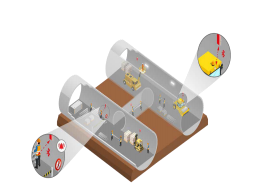Precision Meets Real-Time: How UWB + 4G Enables Millisecond-Level Response
10/19/20255 min read


Understanding UWB Technology
Ultra-Wideband (UWB) technology represents a significant advancement in wireless communication, distinguished by its capability to transmit data over a wide frequency range, typically exceeding 500 MHz. This characteristic allows UWB to achieve high precision in locating and communicating with devices. Unlike traditional wireless technologies, which utilize narrowband frequencies, UWB operates by spreading the signal across numerous frequencies simultaneously. This method not only enhances resistance to interference but also enables greater data transmission capabilities.
One of the most noteworthy features of UWB technology is its exceptional accuracy in positioning. UWB can achieve location accuracy within centimeters, making it ideal for applications that require precise indoor positioning systems. The low power consumption associated with UWB is another significant advantage, as it allows devices to operate for extended periods without frequent recharging. This is especially important in the context of the Internet of Things (IoT), where many connected devices demand energy-efficient communication protocols.
The combined attributes of high data rates and minimal latency position UWB technology as superior compared to traditional wireless communications like Wi-Fi or Bluetooth. UWB can support multi-Gbps data rates while keeping response times remarkably low, often in the order of milliseconds. This makes UWB particularly well-suited for scenarios that hinge on real-time data transfer, such as autonomous vehicles, smart home devices, and critical healthcare applications.
In terms of its applications, UWB is steadily finding utility in diverse industries ranging from automotive and healthcare to manufacturing and consumer electronics. The high precision of UWB facilitates innovations like contactless payment systems and advanced tracking capabilities. As industries increasingly prioritize real-time communication and positioning accuracy, UWB technology is poised to play a pivotal role in shaping the future of wireless communication.
The Role of 4G Networks in Real-Time Communication
4G networks have fundamentally transformed the landscape of wireless communication, establishing the groundwork for real-time data exchange crucial to numerous applications. The architecture of 4G technology is notably designed to support enhanced mobile broadband, enabling users to experience high-speed internet with reduced latency. This network generation employs several protocols that ensure swift and efficient data transfer, which is vital for applications requiring real-time connectivity, including video conferencing, online gaming, and various industrial applications.
One of the pivotal features of 4G networks is their use of Orthogonal Frequency-Division Multiple Access (OFDMA), which allows multiple users to share bandwidth effectively while maintaining low latency. Additionally, 4G networks utilize advanced modulation techniques such as 16-QAM and 64-QAM that contribute to higher data rates. These mechanisms support a robust environment for real-time communication, wherein milliseconds can make a significant difference in performance and user experience.
Moreover, the implementation of key algorithms and protocols such as the Packet Data Convergence Protocol (PDCP) and Radio Link Control (RLC) enhances the transmission efficiency, contributing to lower delay and higher throughput. These elements are particularly relevant when integrating UWB (Ultra-Wideband) technology with 4G networks, as the synergy between both technologies elevates the performance benchmarks for applications requiring millisecond-level responses.
The seamless interplay of UWB with 4G networks illustrates a practical scenario where precision location services can work alongside high-speed data delivery. This combination caters to industries such as logistics, healthcare, and smart manufacturing, where timely information dissemination is paramount. In sum, the architecture and features of 4G networks, bolstered by effective algorithms, are indispensable in establishing environments conducive to real-time communication, thus enabling advancements in various fields.
Combining UWB and 4G: A Powerful Synergy
The combination of Ultra-Wideband (UWB) and 4G technologies represents a significant advancement in precision tracking and real-time data transmission. UWB, known for its capability to provide accurate location data with minimal interference, works seamlessly with the broad coverage and established infrastructure of 4G networks. This synergy allows for enhanced performance across various applications, thereby redefining the landscape of modern connectivity.
In sectors such as logistics, the integration of UWB with 4G allows for meticulous tracking of goods throughout the supply chain. UWB’s ability to determine the exact location of assets can dramatically reduce the time and costs associated with inventory management. When combined with 4G’s high-speed data transmission, stakeholders can monitor their shipments in real time, significantly improving operational efficiency and response times.
Smart cities are another area where the convergence of UWB and 4G manifests impressive results. By enabling precise location services for a variety of urban applications—from traffic management to emergency response—this powerful combination can facilitate smarter urban planning and resource allocation. For example, emergency services can be routed based on real-time data, ensuring they arrive at the scene faster than ever. Furthermore, UWB technology can enhance public safety by accurately tracking people and assets in crowded areas.
The automotive industry, particularly the realm of autonomous vehicles, witnesses immense potential from this integration. UWB’s precise positioning capabilities can enhance vehicle-to-everything (V2X) communication, providing immediate data on surroundings that 4G can rapidly transmit to and from other vehicles and infrastructure. This combination not only improves safety but also fosters a more responsive driving experience, paving the way for fully autonomous navigation.
Ultimately, the integration of UWB and 4G holds exceptional promise for numerous industries, bringing together precision and speed to create responsive environments where milliseconds can make a substantial difference.
Looking Forward: The Future of Millisecond-Level Response Times
The evolution of communication technologies has been remarkable, with ultra-wideband (UWB) and 4G networks paving the way for unprecedented levels of responsiveness in various applications. As we look ahead, the combination of these technologies has the potential to redefine real-time interaction across numerous sectors. Future advancements will likely focus on enhancing latency reduction even further, thereby allowing for even more instantaneous communication in critical areas such as healthcare, transportation, and smart infrastructure.
In healthcare, the integration of UWB and 4G may revolutionize patient monitoring systems. Remote health applications could leverage these technologies to transmit vital signs with millisecond-level response times, allowing for immediate intervention in emergencies. This capability could potentially save lives and improve patient outcomes. Moreover, telemedicine can benefit from reduced latency, fostering more effective doctor-patient interactions, especially in rural or underserved areas.
The transportation sector can also expect significant enhancements. UWB technology can work alongside 4G to improve vehicle-to-vehicle (V2V) and vehicle-to-infrastructure (V2I) communication, thereby reducing reaction times during critical situations and promoting safer driving conditions. The efficacy of smart traffic systems and autonomous vehicles can be vastly improved with these developments, leading to optimized traffic flow and reduced accident rates.
Despite the promising outlook, challenges remain on the horizon. Cybersecurity concerns are paramount as the proliferation of highly responsive systems opens up new avenues for potential threats. Ensuring robust protection mechanisms will be critical to protect sensitive data and maintain user trust. Further, achieving widespread 5G deployment may initially act as a barrier to fully realizing the potential of UWB and 4G integration.
Continuous innovation in communication technologies will undoubtedly better position UWB and 4G to meet the increasing demands of our interconnected world. As we move forward, the collaborative efforts of industry and technology leaders will play a crucial role in shaping an environment where millisecond-level response times become the standard across various applications.
